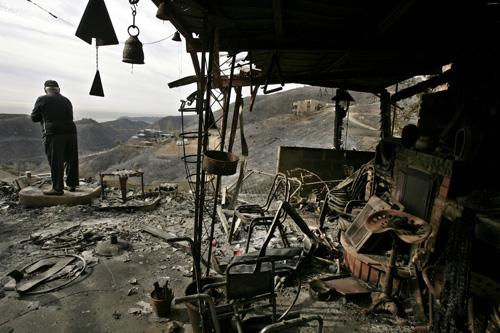Wildfire drives evacuation of Malibu region

Nov 26, 2007
MALIBU, Calif. — A fast-moving wildfire pushed by Santa Ana winds raced through the canyons and over the mountains of this wealthy enclave for the second time in little more than a month Saturday, destroying dozens of homes and forcing as many as 14,000 residents to flee.
The fire erupted in the wee hours after the long-predicted Santa Anas finally returned, and it quickly grew before the winds died down. Forty-nine homes were destroyed and another 27 damaged, said Los Angeles County Fire Chief P. Michael Freeman.
Investigators had determined that the fire, which broke out along a dirt road off a paved highway, was caused by humans, but were still deciding whether it was started intentionally, said county fire Inspector Rick Dominguez.
By night the fire was estimated at 4,650 acres, or about 7 square miles, with 25 percent containment.
“Waking up at 4 in the morning with the smell of smoke in your nose and the wind beating at the windows is something that we learn to live with here, but it always comes as something of a shock,” said Mayor Jeff Jennings.
Get The Daily Illini in your inbox!
All the homes that were destroyed were in the fire’s initial morning surge before the winds slowed and firefighters gained a foothold.
By Saturday evening, about half of the evacuees were allowed to return to their homes, authorities said. The fire had subsided considerably and was expected to be more than half contained Sunday, Freeman said.
Fifteen helicopters and 15 airplanes, including a retardant-dropping DC-10 jumbo jet, attacked from the air while 1,700 firefighters battled flames on the ground. Six firefighters suffered minor injuries.
“Lost homes can be rebuilt, but lost lives can’t,” said Los Angeles County Supervisor Zev Yaroslavsky, whose district includes Malibu. “We’re grateful there were no deaths.”
Helicopters lowered hoses into pools and the nearby Pacific to refill their tanks for water-dropping runs, and SuperScooper amphibious airplanes skimmed the ocean to reload.
The airplanes were grounded at dark, but the helicopters were set to continue dropping water through the night.
Hundreds of firefighters and equipment from throughout the state had been positioned in Southern California for most of the week because of the predicted winds, which had been expected to blow most of the week but didn’t arrive until late Friday.
Officials remained wary despite the decrease in wind speeds.
The mayor said the fire “could have been far, far worse than it was” but still urged residents to “listen to your radios, go outside and see which way the wind is blowing. Stay alert. Stay vigilant.”
Freeman said 10,000 to 14,000 people fled the fire.
A hotspot flared for a time on several ridges behind Pepperdine University, but the campus did not appear to have been endangered. Helicopters used its broad oceanview lawn as a landing zone.
University officials told students to move to a campus shelter as a precaution, although the school remained largely empty because of the holiday weekend.
Another fire near Ramona in San Diego County was fully contained at 50 acres. A firefighter suffered a minor cut when an air tanker flying overhead dropped heavy retardant on a fire engine, breaking its windshield.
Power lines blown down by fierce winds caused last month’s 4,565-acre Canyon Fire in Malibu that destroyed six homes, two businesses and a church. That blaze was part of siege of more than 15 Santa Ana-stoked wildfires that destroyed more than 2,000 homes, killed 14 people and blackened a total of 809 square miles between Los Angeles County and the U.S.-Mexico border.
Santa Anas, triggered by high pressure over the Great Basin, blow into Southern California from the north and northeast, racing down through the canyons and passes of the region’s east-west mountain ranges and out to sea, pushing back the normal flow of moist ocean air.
Malibu, with homes tucked into deep and narrow canyons along 27 miles of coast on the southern foot of the Santa Monica Mountains, is prone to Santa Ana-driven wildfires.
Associated Press writers Chris Weber in Malibu and Noaki Schwartz in Los Angeles contributed to this report


